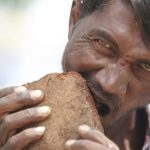 A feeding and eating disorder of infancy or early childhood characterized by developmentally inappropriate, persistent, or recurring eating of nonnutritive substances (e.g., dirt).
A feeding and eating disorder of infancy or early childhood characterized by developmentally inappropriate, persistent, or recurring eating of nonnutritive substances (e.g., dirt).
An unnatural desire for foods; alternative words are cissa, cittosis, and allotriophagy. Also a perverted appetite (eating of earth, sand, clay, paper, etc.).
An eating disorder consisting of the craving and eating of unusual foods or other substances. Seen in a variety of medical conditions, pregnancy, and emotional disturbances.
The Latin word pica—meaning magpie, a bird infamous for eating almost anything—was adopted by doctors in the mid sixteenth century as the name for a pathological desire to eat items like chalk or dirt that are unfit as food. Even today, a doctor might still diagnose someone suffering from extreme and unusual food cravings—a pregnant woman, perhaps—as suffering from pica.
A craving for nonfood items.
A desire to eat things which are not food, e.g. wood or paper, often found in pregnant women and small children.
Habitual consumption of nonfood items such as laundry starch, clay, paint chips, and other items.
The word pica originates from the Latin word for magpie, a bird known for ingesting a wide variety of food and non-food items. Pica as a disorder is characterized by habitual ingestion of inedible substances. Frequently associated with mental retardation, it also occurs in normal young children (younger than age 3) and in pregnant women in certain cultural groups. For example, in infancy and early childhood, children often chew on their cribs, wood, sand, and grass as a method of early exploration. Pica sometimes continues into adolescence and adulthood.
A craving or compulsive desire to eat substances that are not food, such as dirt, clay, paint, laundry starch, chalk, wood, glue, hair, or ice; a kind of eating disorder that often stems from a nutritional deficiency, especially of iron. It also sometimes occurs during pregnancy and may be associated with some forms of mental disorders.
Eating of nonfood substances, such as clay, chalk, hair, or glue; it occurs in some cases of nutritional deficiency, pregnancy, and some mental disorders.
Eating disorder characterized by craving of nonfood items such as clay, paste, or coffee grounds.
An eating disorder in which a person has an abnormal craving to consume substances that are inorganic, such as chalk, clay, paint chips, plaster, dirt, or coal. Pica is most common in children younger than age 6 and the exact cause is unknown. Counseling can often help change the behavior. Although most children outgrow pica, it can continue into adulthood.
The indiscriminate eating of non-nutritious or harmful substances, such as grass, stones, or clothing. It is common in early childhood but may also be found in mentally handicapped and psychotic patients. Although thought to be completely non-adaptive, recent evidence suggests that some patients showing pica may have particular mineral deficiencies (such as iron deficiency).
Latin for magpie, the term is used to describe an abnormal craving for unusual foods, not uncommon in pregnancy. Among the unusual substances for which pregnant women have developed a craving are soap, clay pipes, bed linen, charcoal, and ashes. It is also not uncommon in children, in whom, previously, it was an important cause of lead poisoning due to ingestion of paint flakes.
An eating disorder manifested by a craving to ingest any material not normally considered as food, including starch, clay, ashes, toy balloons, crayons, cotton, grass, cigarette butts, soap, twigs, wood, paper, metal, or plaster. This condition is seen in pregnancy, chlorosis, hysteria, helminthiasis, and certain psychoses. It may also be associated with iron-deficiency anemia. The importance of this condition, the etiology of which is unknown, stems from the toxicity of ingested material (e.g., paint that contains lead) or from ingesting materials in place of essential nutrients. The inclusion of compulsive ingestion of nonfood and food items such as licorice, croutons, chewing gum, coffee grounds, or oyster shells as examples of pica is controversial.
Pica is an unusual longing or desire for non-edible objects, frequently encompassing materials like chalk, clay, soil, cleansing agents, or carbonaceous matter.
An intense desire to consume non-food substances, like soil or coal, characterizes pica. This phenomenon is prevalent in young children and can manifest during pregnancy. Additionally, it might be observed in cases of nutritional deficiencies, particularly lack of iron, as well as in instances of severe psychiatric disorders.
An intense desire for unusual food items; an abnormal appetite. The interpretation varies depending on whether the condition impacts adults or children.
